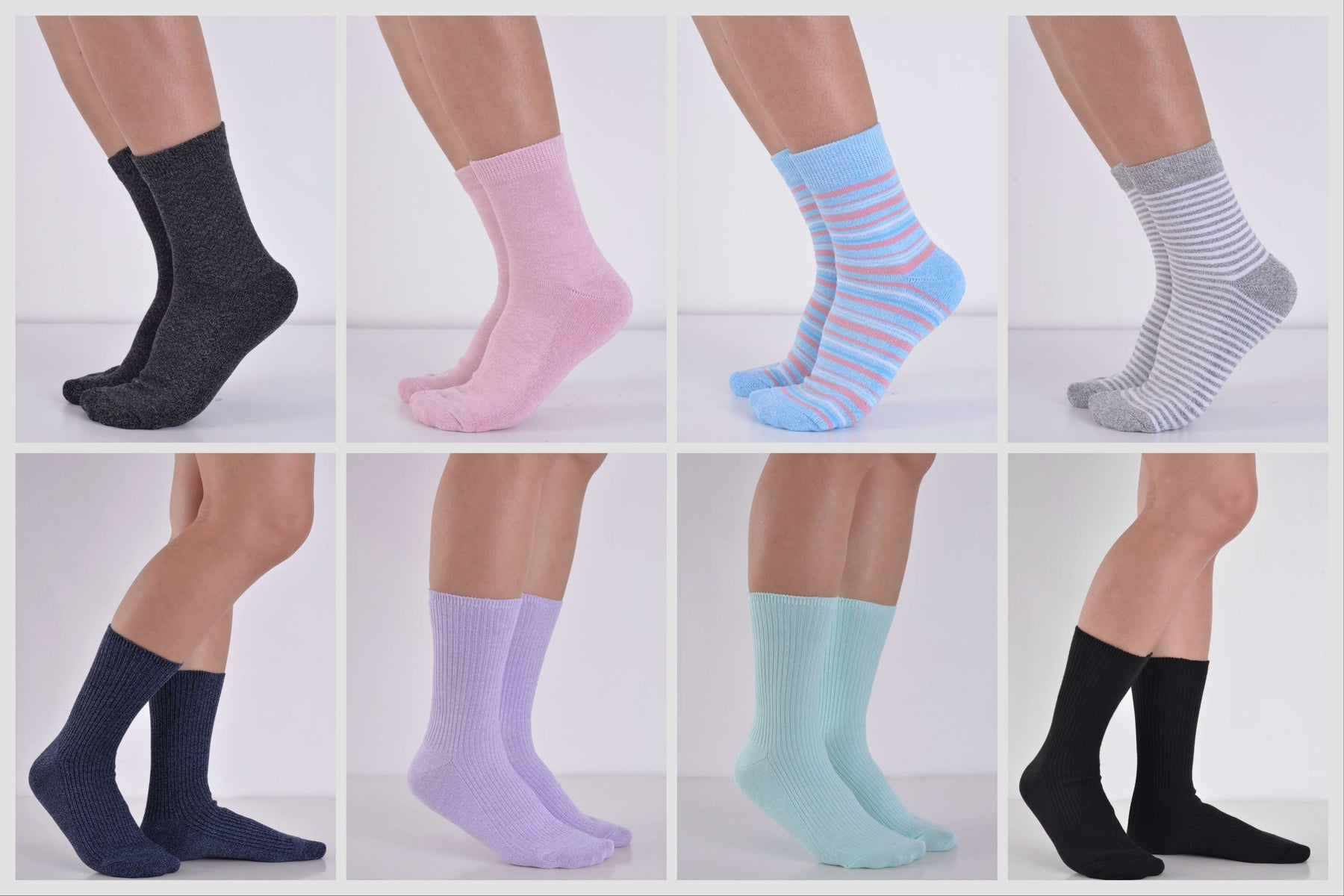
Sole Comfort: The Best Materials for Your Socks

While many people overlook socks as mere accessories, the truth is that they play a crucial role in our daily comfort and well-being. The right pair of socks can enhance your experience, whether you’re navigating a busy workday, enjoying a workout, or simply lounging at home. Each fabric brings its own unique benefits to the table, catering to different needs and preferences.
By understanding the distinct characteristics of each sock material, you can make informed choices that not only elevate your comfort but also complement your personal style. Let’s explore the best sock materials available and discover how they can transform your footwear game for the better.
Bamboo Viscose

Bamboo viscose socks are currently experiencing a surge in popularity due to their ultra-soft texture and impressive moisture-wicking abilities. This natural material is gentle on the skin, making it ideal for people who are prone to irritation or those who simply want to pick a softer alternative. Another great thing about bamboo viscose is its antibacterial and hypoallergenic properties, which help reduce odor while keeping your feet dry and cool throughout the day.
Pros:- Soft and Gentle: Ideal for sensitive skin, reducing the risk of irritation.
- Moisture-Wicking: Helps keep feet dry and odor-free.
- Antibacterial: Resistant to bacteria, which can reduce infection risks.
- Higher Cost: Bamboo viscose socks can be more expensive than socks made from synthetic materials.
- Less Durable: May not be as long-lasting as synthetic fibers like polyester or nylon.
These socks highlight the incredible benefits of bamboo viscose for your feet. Experience the unmatched softness that wraps you in comfort, all-day freshness that keeps you feeling confident, and long-lasting support that carries you through your day. Best of all, you can enjoy these premium features without stretching your budget.
Cotton Blends

Cotton is well-known for its softness and breathability, making it one of the most popular materials for everyday socks. While pure cotton can sometimes trap moisture, blending cotton with synthetic fibers like spandex or polyester helps keep your feet dry and cool throughout the day. With cotton blends, you get the best of both worlds: a soft feel, moisture control, and durability.
Pros:
- Breathable: Provides excellent airflow, keeping feet cool and comfortable.
- Comfortable: Soft and non-irritating, great for everyday wear.
- Absorbent: Manages sweat well, especially when combined with moisture-wicking fibers.
Cons:
- Moisture Retention: Pure cotton may hold moisture, so blending it with synthetics improves its performance.
- Stretch Loss: Cotton socks can lose shape over time if not properly blended with other materials.
We recommend: Pembrook Light Compression Socks
Made from a high-quality cotton blend, these socks offer exceptional comfort and breathability, making them a great choice for all-day wear. The light compression provides just the right amount of support to enhance circulation and keep your feet feeling energized, while the soft cotton material offers a soft and plush feel.
Polyester

Polyester is a highly durable synthetic material that’s a favorite for socks because it wicks away moisture and stands up to wear and tear. It’s great at keeping feet dry by pulling sweat away from your skin, making it an excellent choice for people who are prone to excessive sweating or those who are always on the move. Additionally, polyester socks dry quickly and hold their shape really well, so you can count on them for long-lasting performance.
Pros:
- Moisture-Wicking: Helps to keep feet dry, preventing sweat build-up.
- Durable: Resistant to wear and tear, ensuring socks last longer.
- Quick-Drying: Dries faster than natural fibers, making them great for active use.
Cons:
- Less Breathable: May not be as breathable as natural materials like cotton or bamboo.
- Not as Soft: Can feel less soft against the skin compared to natural fibers.
Crafted from a comfy polyester blend, they offer a fantastic level of stretch while still being all about durability. Thanks to their moisture-wicking properties, they keep sweat at bay, so your feet feel fresh all day long. And the bonus part? They come with grips to give you that extra traction you need to stay stable on smooth surfaces.
Nylon

Nylon is a tough and durable material that significantly enhances the structure and longevity of socks. Often blended with other fibers, it adds that extra resilience to protect against everyday wear and tear. Nylon socks also have a smooth feel that helps reduce friction and irritation, which means fewer blisters.
While nylon doesn’t wick moisture on its own, it works great with materials like cotton and polyester to create comfy, long-lasting socks that you’ll love wearing.
Pros:
- Durable: Nylon socks are highly resistant to wear and tear, making them last longer.
- Shape Retention: Helps socks maintain their shape and structure, preventing sagging.
- Smooth Texture: Feels soft and smooth, reducing friction against the skin.
Cons:
- Not Moisture-Wicking: Nylon doesn’t wick moisture well on its own, so it’s best blended with other fibers.
- Less Breathable: Without other materials, nylon can trap heat and moisture, causing discomfort.
We recommend: Pembrook Plus Size Compression Socks
These socks are crafted from a durable nylon blend, offering the perfect balance of support and comfort. The compression feature is fantastic for enhancing circulation and keeping your feet feeling energized all day long. While they’re tailored for plus sizes, they provide a snug fit that works well for most foot shapes and sizes. With their smooth texture and cozy design, you’ll love the way they feel with every step.
Spandex (Lycra)

Spandex is commonly added to sock blends to give them extra stretch, comfort, and help them hold their shape. It makes socks flexible so they stay in place without bunching up or slipping down. Another great thing about spandex is that it adds support without the tightness, keeping the fit snug and comfortable while letting the socks move with you throughout the day.
Pros:
- Stretchy: Provides excellent elasticity for a secure, comfortable fit.
- Shape Retention: Helps socks maintain their shape even after repeated wear.
- Lightweight: Adds flexibility without adding bulk, making socks more comfortable.
Cons:
- Not Breathable: Spandex itself isn’t breathable, so it’s often blended with other materials.
- Slightly Synthetic Feel: While useful, the stretch of spandex can sometimes feel artificial.
We recommend: Pembrook Ribbed Knit Diabetic Socks
These socks combine the best of everything with their blend of bamboo viscose, polyester, and spandex. The stretchy spandex ensures a comfortable fit that adapts beautifully to your feet, while polyester enhances durability and helps maintain the sock’s shape. Bamboo viscose adds breathability and moisture-wicking properties to keep your feet feeling fresh. Plus, with the ribbed knit design, you’ll not only feel great but look stylish, too.
In summary, selecting the right sock material can make all the difference in your comfort and overall experience. Whether you’re leaning towards the plushness of bamboo, the breathability of cotton, or the durability of polyester, there’s a perfect sock out there for everyone. So, as you shop for your next pair, remember that the right materials can elevate your day from just okay to truly fantastic. Happy sock shopping!
